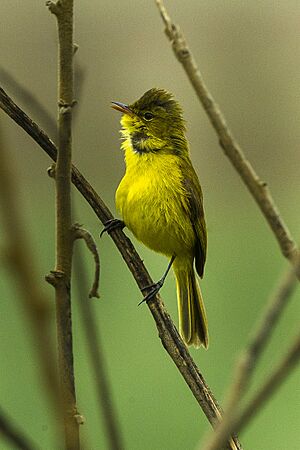African yellow warbler facts for kids
Quick facts for kids African yellow warbler |
|
|---|---|
 |
|
| In South Africa | |
| Conservation status | |
| Scientific classification | |
 |
|
| Resident range | |
| Synonyms | |
|
Chloropeta natalensis |
The African yellow warbler (Iduna natalensis) is a small, bright bird. It is also known by other names like the Natal yellow warbler. This bird belongs to a family of birds called Acrocephalidae warblers. They used to be grouped with other "Old World warblers."
Contents
What Does the African Yellow Warbler Look Like?
The African yellow warbler is a medium-sized bird. Its upper body and tail are yellowish-brown. The top of its head is a bit browner, and its lower back is yellower. Its wings have brown feathers with yellow edges.
The underside of the bird is bright yellow. The sides of its chest, flanks, and lower belly have a slight olive green color. Its beak is light on the top and dark on the bottom. Its legs are dark.
Female warblers have duller yellow undersides. Young birds look similar to males but are a bit more buff-colored. These birds are about 13 cm (5.1 in) long. They weigh between 10 and 15 g (0.35 and 0.53 oz).
What Does the African Yellow Warbler Sound Like?
The African yellow warbler has a fast and varied song. It often starts with a few rough notes. Then it sings a quick series of clear, deep sounds. For example, it might sound like "chip-chip-chip- whee-lee-wheeo." When it senses danger, its alarm call is a sharp "tsk" or "chirr."
Where Does the African Yellow Warbler Live?
The African yellow warbler likes to live in thick, tall plants. You can find it in reeds and plants growing near water. It also lives at the edges of forests. It especially likes places where these areas meet wetter ground.
How Does the African Yellow Warbler Live?
The African yellow warbler usually looks for food low in the plants. It hunts alone or in pairs. This bird can be quite shy. However, it will climb onto an open branch to sing. If it feels disturbed, it will quickly hide in the plants. It then creeps away quietly, almost like a mouse.
The warbler mainly eats insects. It picks caterpillars and other bugs off leaves and branches. It also catches flying termites. It flies out from a branch to catch them in the air. Then it returns to its perch to eat its prey.
Nesting and Raising Young
The African yellow warbler builds a neat, cup-shaped nest. It uses grass to make its nest. The nest is usually placed in the fork of branches within a bush. It can also be found between upright plant stems. In southern Africa, they often nest in plants like Leonotis or Conyza.
Females lay 2 or 3 eggs. In southern Africa, this happens from September to March. The eggs are kept warm for about 12 days. The female bird does most of the egg warming. After the chicks hatch, both parents feed them. The female feeds them much more than the male. The young birds leave the nest when they are about two weeks old. They become fully independent at about 6 weeks old.
How Scientists Classify the African Yellow Warbler
This bird was first placed in a group called Chloropeta. This group also included the mountain yellow warbler. However, scientists have studied the DNA of these birds. They found that the African yellow warbler is closely related to other warblers. These include some bush warblers from Europe and Asia. It is also related to the thick-billed warbler.
Types of African Yellow Warblers and Where They Live
There are four main types, or subspecies, of the African yellow warbler. They live in different parts of Africa:
- Iduna natalensis batesi: Lives from Nigeria east to the northern Democratic Republic of Congo and western South Sudan.
- Iduna natalensis massaica: Found in western and southern Ethiopia, eastern South Sudan, northeastern Democratic Republic of Congo, Uganda, western and southern Kenya, and northwestern and northeastern Tanzania.
- Iduna natalensis major: Lives from Gabon east to southern Democratic Republic of Congo. It also lives south to Angola and northern Zambia.
- Iduna natalensis natalensis: Found in southern Tanzania, Malawi, southern Zambia, northern and eastern Zimbabwe, northwestern and western Mozambique. It also lives in eastern South Africa and Eswatini.


